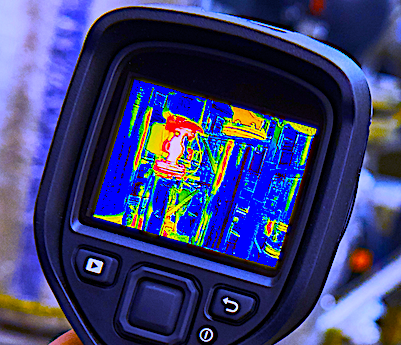A little over a year ago (Nov. 18, 2019), I wrote a newsletter column titled, “The Most Wonderful Time of Year” (see link below). In it, I highlighted how maintenance departments often go on shopping sprees with unspent budget dollars at the end of the year and purchase expensive diagnostic tools that wind up unused and forgotten in a supervisor’s locked cabinet.
I recently worked with a client where, upon examination of the organization’s specialty tools and predictive programs, numerous, barely used, handheld infrared (IR) cameras were discovered in a locked cupboard in the planning department. The devices had apparently been purchased years earlier with a budget-surplus account and never introduced into the maintenance population. Furthermore, no PM job task incorporating the use of the these thermal imagers existed, and any infrared-inspection work performed in the corporate facilities was being executed by outside contractors on an as-needed basis.
Sadly, my client’s situation is not unusual: Too many maintenance departments restrict access to technology tools and fail to incorporate them into to daily maintenance use. This is somewhat ironic when maintainers can be trusted to resolve issues with sophisiticated multi-million dollar assets, but are denied access to valuable diagnostic tools that can immediately and simultaneously benefit the maintainer, asset, and operation.
Click Here To Read The Referenced Nov. 18, 2019, Newsletter Column
“It’s The Most Wonderful Time Of The Year”
A BETTER APPROACH
Technology tools have have finite life cycles based on a phenomenen known as “technology depreciation.” This depreciation is a result of the technology/software becoming too old to be supported and the next-generation replacement often being cheaper than upgrading the existing hardware/software. If you own a computer, tablet, cell phone, or camera, you will have already faced this dilemma numerous times. Thus, if a site owns technology tools, the motto should be, “If we don’t use it, we will soon lose it!” The time to incorporate their use in daily maintenance activities is always NOW.
As we move into a new calendar year, I challenge every maintenance department with locked cabinets, cupboards, and closets to take stock of the site’s technology tools. These could include IR cameras and thermometers, laser-alignment systems, vibration meters/systems, soft- foot meters, portable oil-analysis mini labs, multi-meters, and electronic strobes, among other advanced technologies.
After you’ve freed those instruments and devices from wherever they’ve been stowed or hidden away (often in their orginal, unopened boxes), assess their levels of technology depreciation to determine if they are still current and useable in your operations. This may require contacting the original tool supplier. In the process, find out if online training is now available for the tool or technology in question. For sites that are already using such tools, consider reintroducing the technology in the same manner.
The next steps involve placing all technology tools on display in the maintnenance department and showcasing how they can be typically used within your plant. Invite maintenance staff to expand the usage/deployment capabilities throughout the facility, and work with the planning department to update relevant existing PM job tasks to incorporate use of these tools moving forward. Once all that has been done, standard operating procedures can be drawn up from manaufacturers’ operating manuals and, in many cases, augmented with the manufacturers’ and users’ online videos that often feature helpful case studies and success stories.
THE BOTTOM LINE
Much has changed in the maintenance workplace over the past year. Operations that have been deemed essential producers of goods may be operating at full or over-design capacity, stretching the limits of their maintenance programs. Conversely, companies deemed non-essential may be in partial, slow-down, or shut-down mode, with their maintenance organizations operating under a modified approach. Whatever a company’s current situation is, though, it, like all all other organizations, regardless of sector, can capitalize and benefit from building and maintaining a robust technology toolbox.TRR
ABOUT THE AUTHOR
Ken Bannister has 40+ years of experience in the RAM industry. For the past 30, he’s been a Managing Partner and Principal Asset Management Consultant with Engtech industries Inc., where he has specialized in helping clients implement best-practice asset-management programs worldwide. A founding member and past director of the Plant Engineering and Maintenance Association of Canada, he is the author of several books, including three on lubrication, one on predictive maintenance, and one on energy reduction strategies, and is currently writing one on planning and scheduling. Contact him directly at 519-469-9173 or kbannister@theramreview.com.
Tags: reliability, availability, maintenance, RAM, maintenance management, infrared cameras, IR cameras, thermal imagers, infrared thermometers, laser-alignment systems, vibration meters/systems, soft- foot meters, portable oil-analysis mini labs, multi-meters, electronic strobes



